
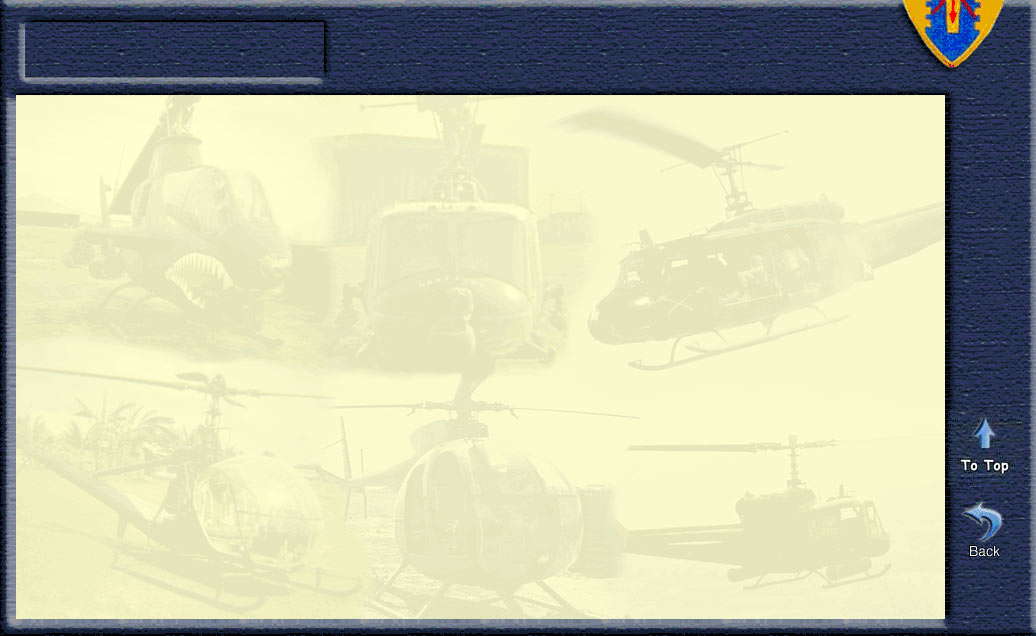
The History of "Wargasm" LOH 795
This essay describes the special bond between aviators and their aircraft. It was inspired, researched, and documented by Curt Knapp.
It is told as a first person account by the coauthor, Carl Betsill
See Dave Ripley Update 22 April 2022
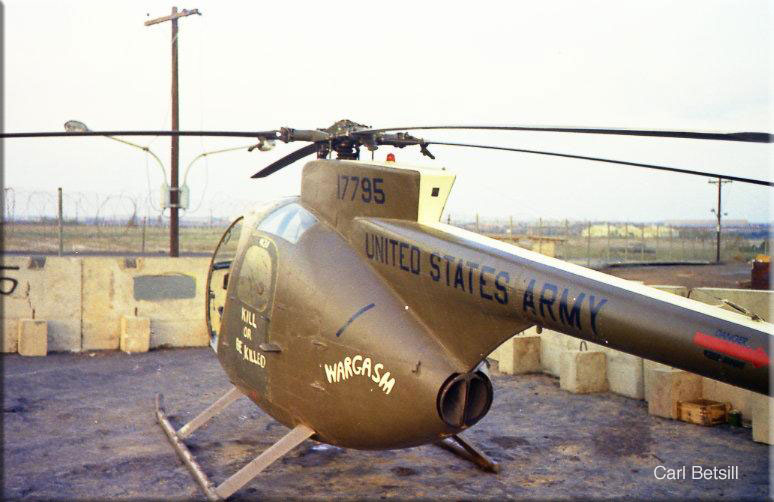 Carl Betsill: This story is about a Centaur aircraft with a very long history and was employed by many pilots in Vietnam besides those in F-Troop, 4th Cavalry Regiment.
Carl Betsill: This story is about a Centaur aircraft with a very long history and was employed by many pilots in Vietnam besides those in F-Troop, 4th Cavalry Regiment.
I first became interested in the long history of aircraft serial number 66-17795 when I came across a post on the Internet. It was about twenty years ago when I decided to try an Internet search for Lai Khe, Vietnam.
Figure 1: The picture sent to Curt Knapp from Carl Betsill around the Year 2000. (photo by Carl Betsill)
What I found was a website called The Green Book named after what I assume was the green log books kept in all our aircraft. It was a site about F-Troop, 4th Cavalry Regiment at Lai Khe. They had what they called a bulletin board in those days where you could post comments or questions to other viewers on the website. One such post was from a Warrant Officer by the name of Curt Knapp. Curt stated that he was putting together a history of an OH-6A, serial number 66-17795, that he flew in Vietnam. He had found out from the Gold Book records that 795 had been assigned to F-Troop sometime later in the war and wanted to know if anyone had any pictures or knew any history of the aircraft while it was in our unit.
I’m not sure why I bothered, after all what are the odds that I had a picture of his aircraft, especially one that showed the serial number? At any rate I went to the trunk where I kept all my old yellowing photographs and started going through them looking for 17795. I must have had 50 photographs and at least that many slides. About the 5th photograph I looked at, however, was a photograph with the serial number clearly visible on the dog house (Figure: 1).
The reason I took the photo was obvious. The name on the cowling around the exhaust was Wargasm! “Kill or be Killed” was stenciled on the door.
To this day, I’m still unsure where I took the photograph. It was definitely not Lai Khe. I thought it was Long Binh, but with all the telephone wires and poles, I now think it may have been at Chu Chi. We used the abandoned base at Chu Chi to stage missions in early 1972. (Note: You can find the location of the bases mentioned in this article by clicking here for our Map Location page.
As I recalled, I called Curt in response to his post and told him I had a picture and that I would scan it for him. I know I was still using a dial up modem then, so I’m not sure if I was able to send it electronically or not. At any rate when Curt got the photo he was amazed and I think a little shocked. I recall him asking: “What have you guys done to my beautiful little bird!” He went on to explain that he was one of the first to fly 17795 in Vietnam.
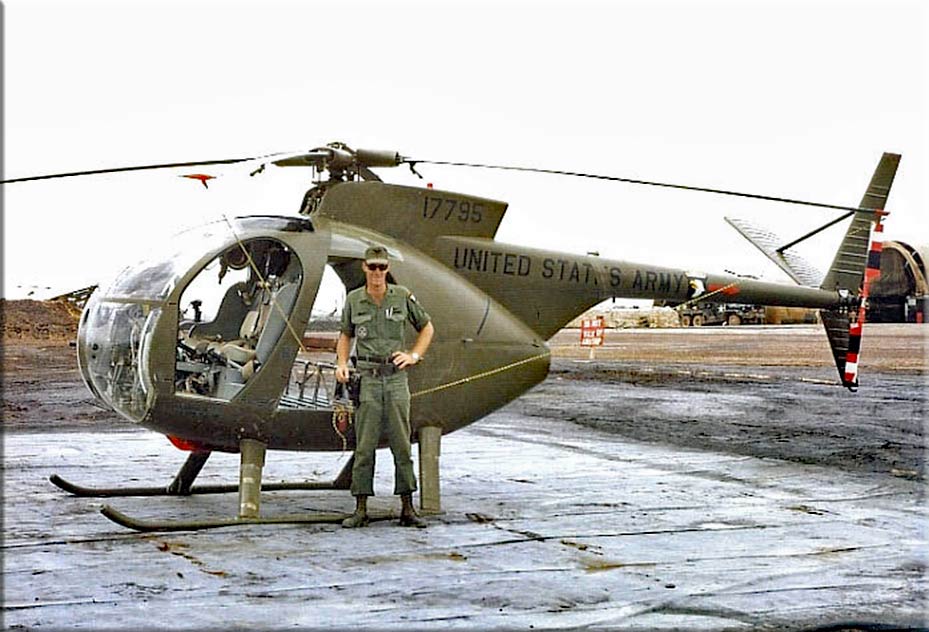
Figure 2: A brand new 795 at LZ Sally. Pictured with Curt Knapp (Photo provided by Curt Knapp)
Below is Curt’s account of his experience with 795 with notes from his Journal.
Curt Knapp: May 19, 1968 - 795 arrived at LZ Sally in northern I Corps, the base for the 2nd Brigade of the 101st Airborne
Division (Figure: 2). [ A few months later the name was changed to the 101st Air Cav Division. I knew that wasn't gonna work, and sure enough very soon after that it went to the 101st Airborne Division ( Airmobile ).] 795 was technically assigned to the Aviation Section, HHC, 2BDE, 101 ABN. At that time we had 3 pilots ( WO1 Curt Knapp. WO1 Bill Savedge, and WO1 Craig Smith ) and sometimes 3 flyable OH-23Gs.
By the end of my tour the Hillers (OH-23s) had been replaced by 2 Loaches and 2 H- Model Hueys. The Aviation Section had also grown to a Platoon of about 30 or so pilots and enlisted men. And not to say we never went looking for trouble, but during my time there 795 never had a mini-gun.
Bill had previously flown the brand new 795 up from Chu Lai to 801st Maintenance at Camp Eagle for a day or so of acceptance inspection. 795's arrival at Sally was greeted by the explosion of the ammo dump at Camp Evans just up the road. 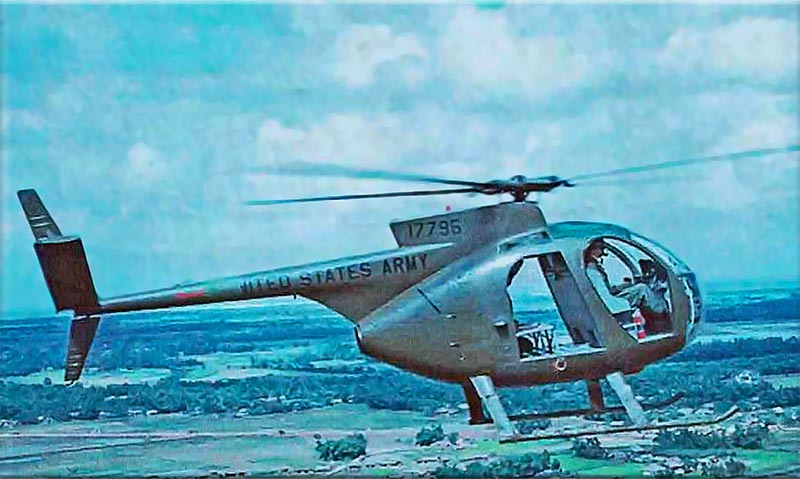 Any 1st Cav guys there at the time will remember that one. Bill also had an interesting event on his way up from Chu Lai. The pilot's right side door became partially unlatched and caused
Any 1st Cav guys there at the time will remember that one. Bill also had an interesting event on his way up from Chu Lai. The pilot's right side door became partially unlatched and caused
the corresponding overhead greenhouse to implode. Bill thought he'd been hit! But being the cool-headed warrant that he was, he managed to hold the door shut, work the cyclic, collective, pedals, and chew gum all at the same time. At Sally we ordered a new greenhouse panel and temporarily fixed the gaping hole with good ol' Army Green Tape (Figure 3).
Figure 3: 795 showing green tape over the greenhouse. (Photo by Curt Knapp)
By the time I DEROSed in mid -December the area of tape coverage kept increasing but the panel wasn't yet replaced.
On May 29th I noted that "..the ADF in this LOH sure is great. Just tune in AFVN Da Nang and listen to American sounds. Good ol' Monitor even." The next day I noted: "GEN Abrams & boucoup other stars visited with us today. But even their Huey couldn't outrun my little Loach." The transition from Killer Hillers to that Hughes was like going from your father's '53 Chevy to a brand new Porche!
On the night of June 3rd 795 and I had our closest brush with death, and it was all my fault. I'd been working with COL Beckton's 2/17 Cav crowd all day near Phu Bai across from the 101st's division HQ at Camp Eagle. He released me around 1900 just as it started to rain. Of course it rains all the time in Vietnam, and LZ Sally was just up Highway 1 past Hue a little ways. A case of Get-home-itis was setting in. I had made the parts run between Sally and Eagle in my Jeep on Highway 1 boo-coo times, so off I went low-level. Well, the rain and wind got heavier, the sky got a lot darker, and my butt got tighter. I lost sight of the highway, and I was concerned about hitting a pole or a tree or a house or something. At least I wasn't concerned about Charlie being out in this weather.
So remember that instructor in flight school who said during a night autorotation turn on your landing light. If you didn't like what you see - turn off your landing light. Well, after turning mine on all I could see was bright white light obscuring everything around me, and I didn't like it. So I turned off the light. Y'know, it's funny what goes through your mind at times like this. No, it wasn't my entire previous life. It was that time in flight school when another instructor said if you get yourself into inadvertent meteorological conditions that preclude further attempts at forward flight...TURN AROUND AND GO BACK TO WHERE YOU WERE RELATIVELY SAFE! So, by golly, with a death grip on the controls that's exactly what I did. After what seemed like a loooong time we popped out near those 3 radio towers right outside of Phu Bai. Those of you who flew in I Corps know which ones I mean. WHEW!
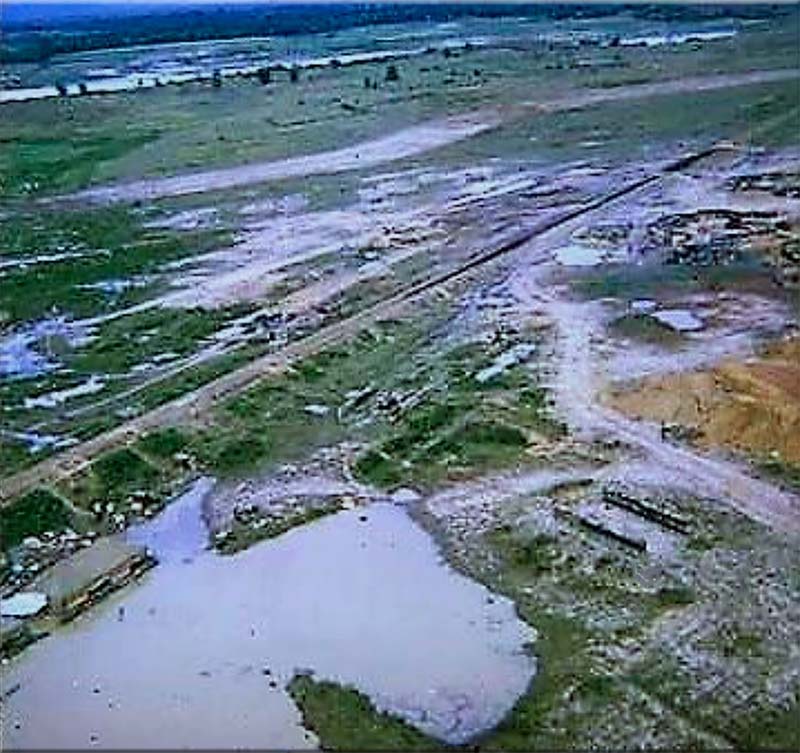 Next I had to find Camp Eagle which was just across the highway, but it was blacked out for security. Phu Bai GCA was down or at least not answering, but I
Next I had to find Camp Eagle which was just across the highway, but it was blacked out for security. Phu Bai GCA was down or at least not answering, but I
managed to raise some poor guy on the ground at Eagle who volunteered to go out in the storm and drive a Jeep to POL or somewhere I could land. Naturally the Jeep's steering wheel was chained, so he turned on the headlights and that's where I landed. I spent the night on a spare cot next to a bunch of rowdy Cav guys. And I was just as loud as they were singing those corny songs like, " She'll be coming around the mountain when she coooomes ! "
The next day when I got back to our pad at Sally, The Pond was more like a lake (Figure: 4)! We wouldn't have made it.
Figure 4: "The Pond" at LZ Sally after the storm that forced Curt to return to Camp Eagle. (Photo by Curt Knapp)
A few days later on June 9th I was out at Quang Dien picking up "Strike", the CO of 1st Battalion 502nd Infantry Regiment when his RTO walked into my blades with his PRC-25 radio antenna up. I flew to Sally, shut down, and found a 1/4 inch dent on one blade. I then flew to 801st Maintenance at Camp Eagle, but they didn't have a blade. My Aviation Section CO was jumping through his ass 'cause the Brigade CO was pissed, so Major Lee went all the way down to Da Nang and scrounged a blade. Two days later I was cooling my heels at 801st while they tried to get some cat eyes to track 795's blades. Finally my crew chief, SP5 Bruce Horton, and I flew back to Sally in one of our H- 23s they had just fixed, got some reflective tape I had brought from the States, brought it back, and everybody continued to march.
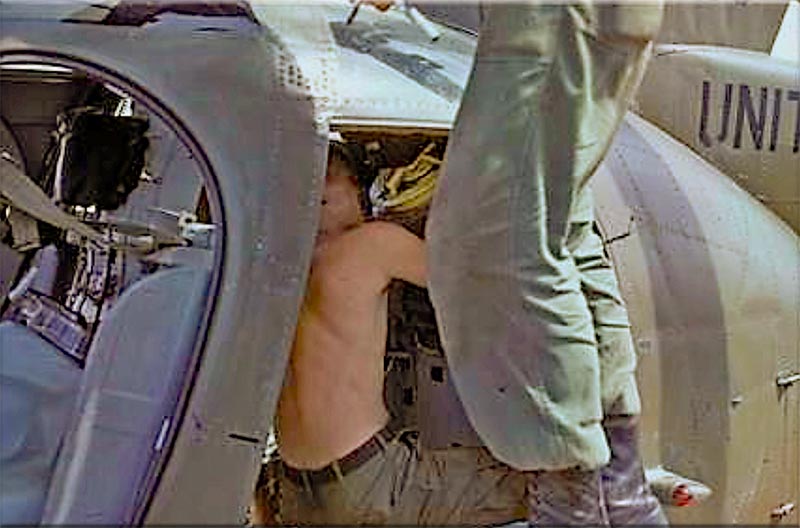 Figure 5: Changing the Transmission in 795. (Photo by Curt Knapp)
Figure 5: Changing the Transmission in 795. (Photo by Curt Knapp)
On July 9th I noticed a high frequency vibration when my feet started going to sleep on the pedals. I wrote it up, but I flew it down to Camp Eagle the next day on a circle red
X. They eventually said that they had installed the tail rotor "the wrong way" last time. But this hi-freq persisted, and on August 6 we changed the transmission (Figure: 5).
My journal notes: "...then true to fashion everything went to sh__. As usual it's a long story, and after all that ' by-the-numbers jump-through- your ass ' the LOH is still sittin' out there!"
The next day, on August 7th, Willie, one of my gunners, and I drove to 801st and brought back an APU to start 795, which of course didn't work. We had to stop-drill a couple places that were cracking on the tail structure. By August 10th " Major Lee was jumpin' all over me about that frickin' LOH, so I had 'em hook the damn thing outta here (Figure: 6)!"
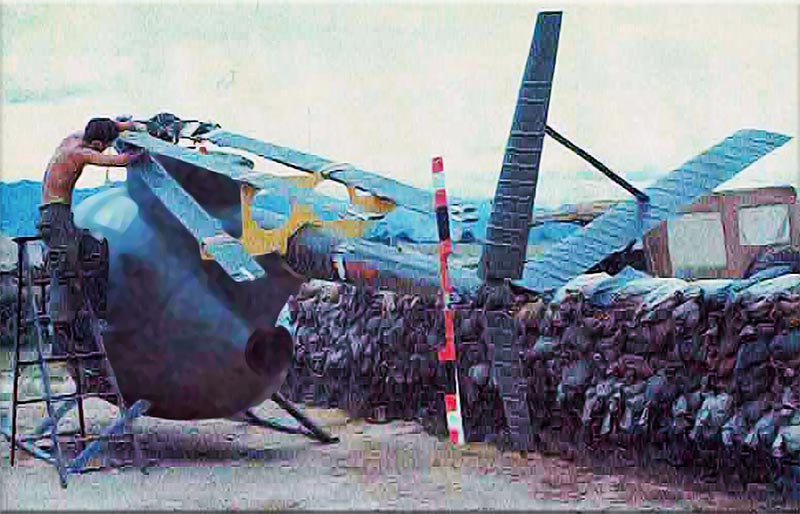 Somewhere between here and August 26th 795 was flying again. My journal says I took "...the
Somewhere between here and August 26th 795 was flying again. My journal says I took "...the
LOH to [Camp] Evans to have a Hughes tech rep put his ' little black box ' on it. He says it's the tail rotor gear box." AH-HA! So after swapping it out, that was the last problem I had with 795 during my tour.
Figure 6: 795 being prepared for transport from LZ Sally to Camp Evans (August 10, 1968. (Photo by Curt Knapp)
Curt had nursed 795 through many mechanical problems but it carried him through enemy
fire, and returned him safely at night through blinding rainstorms.
By the end of Curt’s tour man and machine had developed a bond that would last a lifetime. Little did Curt know when he left on that December day in 1968 that he would be reunited with and fly 795 again at a small little peaceful airfield in Hampton, Georgia.
Another pilot mentioned in Curt’s account is the late Bill Savedge. His account is recorded in an article discussing the restoration of 795 in the February 1999 issue of Rotor & Wing. Bill’s account is as follows:
“The LOH served as an unarmed command-and-control ship, call sign “795”. Savedge picked it up in Quinhon, South Vietnam on May 28, 1968, and delivered it to a nearby maintenance battalion designated “Camp Eagle”.
One of the most dangerous tactics he says the Army performed with the helicopter was to fly back and forth over the enemy to draw their fire so that American artillery could hone in on the enemy guns and destroy them.
Did they lose many helicopters that way? “Surprisingly, no. We never had any of our ships shot down while I was there,” says Savedge, who now works for a medical supply distributor in Richmon, VA. “You did a lot of innovative things and a lot of stupid things. Mostly stupid things. Sometimes you wondered how in the world you were able to get back”. Obviously, Bill was another pilot that had a long term attachment to 795.
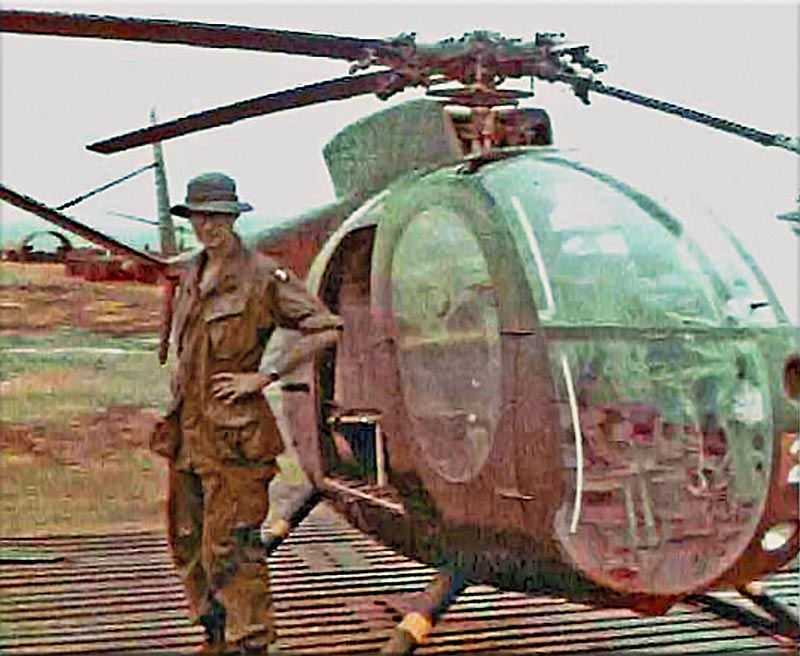 After Bill and Curt’s tour another individual develops a lasting relationship with 795. This time it is crew chief, SP4 Art Cagney (Figure: 7).
After Bill and Curt’s tour another individual develops a lasting relationship with 795. This time it is crew chief, SP4 Art Cagney (Figure: 7).
Figure 7 : Sp4 Art Cagney, Crew Chief Dec. 1968 - Jan. 1970 (Photo provided by Art Cagney)
In Curt’s lifelong search for the history of 795 he received the following email from Art describing his first encounter with 795.
“795 was one of two Loaches at the time. 795 was dirty and full of sand. The first thing I did was clean the bottom of the glass bubbles with a toothbrush and a piece of paper. We did not have any water to wash anything except the swamp water which smelled like piss and looked like S---. I noticed the upper bubble was taped. The first one I remember flying it was Major Phillip Lee. I do not know what happened to the previous crew chief. No one was assigned when I got there. Back then we never flew more than 20-30 miles away from Sally. It was mostly used for ferrying people around to Camp Evans and Camp Eagle. Back in those days we did not have an APU. Everything was a battery start with no spare batteries. The pilots had one chance.”
I called Art in preparation for this article and he told me other stories about 795. During Art’s tour, the shine had worn off the new Loach and it was no longer the senior officer’s top choice for a mode of transportation. Now 795 was functioning as she was intended; as a scout aircraft working in a white team. At times, she even sported a mini-gun. If purple hearts were awarded to aircraft, 795 would have had many. Art recalls at least 10 bullet holes in the aircraft during his tour. Art also recalls a pilot flying through a flock of ducks during a low level flight severely damaging the aircraft but with no injury to the crew.
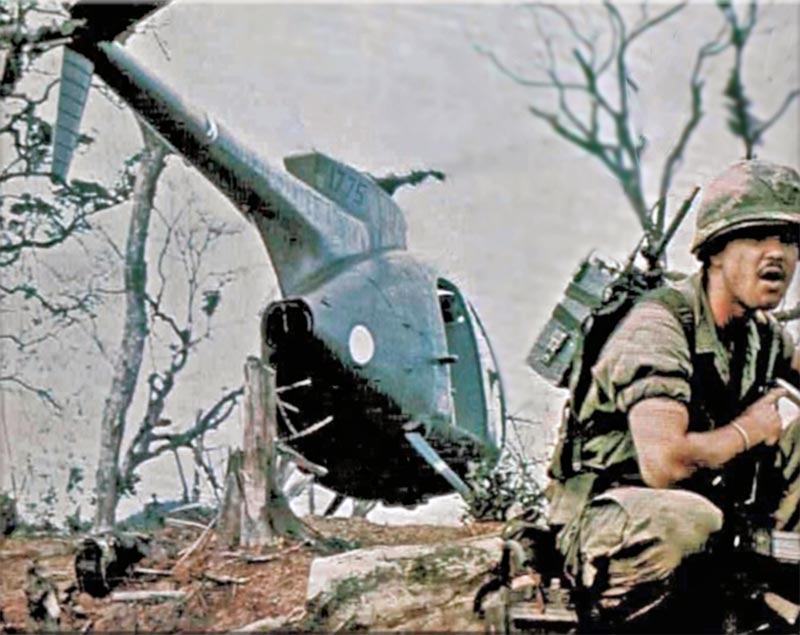 One of the most memorable assignments 795 was engaged in occurred mid-May of 1969 on Hill 937, better known as Hamburger Hill. 795 was flown on six missions to the hill to ferry water and commanding officers and bring back the dead and wounded (Figure: 8).
One of the most memorable assignments 795 was engaged in occurred mid-May of 1969 on Hill 937, better known as Hamburger Hill. 795 was flown on six missions to the hill to ferry water and commanding officers and bring back the dead and wounded (Figure: 8).
Art remained at LZ Sally to make room for the water on the flight out and the casualties on the way back. Instead of door gunner, his job for these missions was loading and unloading his aircraft.
Figure 8: 17795 on Hamburger Hill, May 1969. Photo from 101st Airborne Newpaper.
By the end of Art’s tour, 795 had earned the title of “Veteran”.
Below is an article that appeared in the 101st Airborne Division’s newspaper:
No. 795 - A True Vet
LZ SALLY – The Airmobile concept has created a new king of “veteran” in Vietnam. Aviators now take
great pride in flying an aircraft with a long record of combat missions.
The men of Headquarters Aviation Platoon of the 2nd Bde think they are currently flying one of the true veterans of Vietnam – Light Observation Helicopter No. 795.
Spec. 4 Arthur F. Cagney of Buffalo, N.Y. is crew chief of No. 795 and has been flying in the aircraft since he came in country in December 1968.
“When I was first assigned here”, he says, “No. 795 had only flown about 30 hours in over a month, but since the Division has become Airmobile, our missions have increased greatly.”
Some of the 2nd Bde aviators decided to check on the history of No. 795. Maintenance personnel of B Co., 5th Transportation Battalion (Airmobile) in Phu Bai have confirmed that No. 795 has logged over 1000 hours in the air – the most of any LOH in the Division.
Says. Cagney, “We feel that No. 795 is one of us because it broke most of us in to scout ship flying in Vietnam.”
In addition to routine scout and courier mission, No. 795 has been used to qualify every 2nd Bde LOH pilot this year.
By December of 1970 records show that 795 was returned to the United States and assigned to US Army Aviation Systems Command in St. Louis, Mo; Sharpe Army Depot in Lathrop, Ca; and then Lexington Army Depot in Avon, KY before returning to Vietnam in October of 1971.
After the much needed R&R 795 takes on an entirely new role when she returns for her “Second tour”. She is assigned to the 11th Armored Cavalry Regiment or at least what remained in Vietnam of the 11th. Curt’s history has a photograph of Wayne Mutza, crew chief with 795 and he indicates on the back of the photo that he was with the 11th Armored Cavalry Unit at Phu Loi. Records show the 11th leaving Vietnam in August 1971 and stationed in Di An instead of Phu Loi. One can only assume that the situation is similar to D-Troop when the 25th left Vietnam. It seems a lot of Cavalry Aviation units were orphaned when their main units returned to the states.
The 11th Cavalry, apparently being a typical cavalry unit, was not quite as up-tight as the 101st about regulations. No. 795, as she was named by the 101st, quickly became known as Wargasm (See Figure: 1) with the 11th. No longer did she fight alone or with other scouts (White Team), she was paired with an AH-1G Cobra gunship (Red Team) and would fight as what became known as a Pink Team or a Hunter-Killer Team.
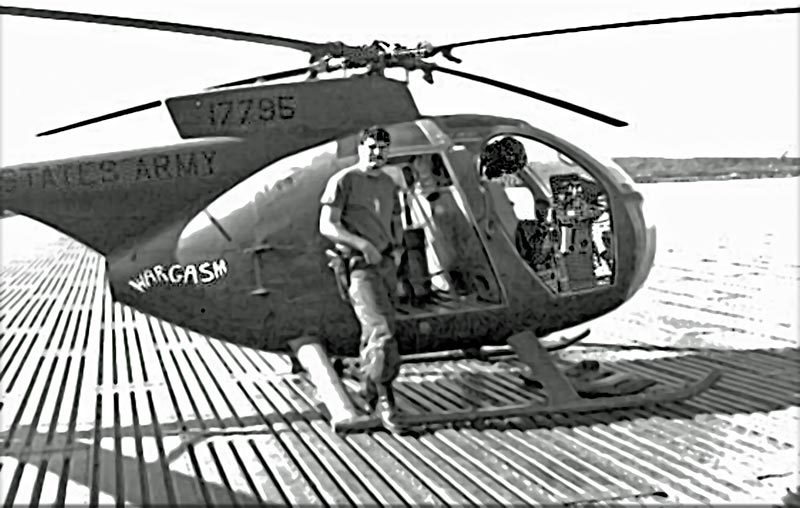 After a short 5 month tour with the 11th, Wargasm is assigned to F- Troop, 4th Cavalry Regiment in March 1972. F-troop was then stationed in Long Binh at Sanford Army Airfield. It was sometime during this short window of time before the move to I Corp in early April that the Figure 1 photo was taken. In early April Wargasm came full circle and returned to the area she flew during her first tour. Camp Eagle, LZ Salley and Phu Bai werre again familiar airfields.
After a short 5 month tour with the 11th, Wargasm is assigned to F- Troop, 4th Cavalry Regiment in March 1972. F-troop was then stationed in Long Binh at Sanford Army Airfield. It was sometime during this short window of time before the move to I Corp in early April that the Figure 1 photo was taken. In early April Wargasm came full circle and returned to the area she flew during her first tour. Camp Eagle, LZ Salley and Phu Bai werre again familiar airfields.
Figure 9: Dave Ripley Scout Pilot, ACT 11ACR and D Troop 229.
Wargasm’s detailed history with F-Troop is really sketchy. Official records indicate 60 hours logged in Mar 1972, 58 hours in April and 67 hours in May. In June, records indicate the aircraft was returned to CONUS.
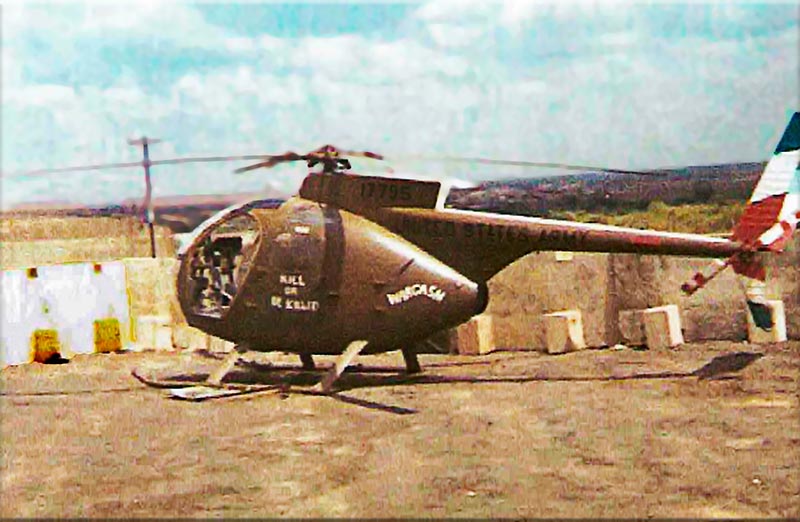 These records, of course, are not exact. Some have stated that Wargasm was the aircraft CPT Ron Radcliffe flew on February 20th during the incident when CPT James Hamrick and SP4 Don Ware were KIA. CPT Radcliffe states that he does not remember which aircraft he was flying.
These records, of course, are not exact. Some have stated that Wargasm was the aircraft CPT Ron Radcliffe flew on February 20th during the incident when CPT James Hamrick and SP4 Don Ware were KIA. CPT Radcliffe states that he does not remember which aircraft he was flying.
It is known that CPT Radcliffe and 1LT Blaha, among other pilots, flew Wargasm during its three month tour with F-Troop.
Figure10: Photo of Wargasm. It appears to be in the same revetment as Figure1. (Photo by Frank Dillon)
When asked the reason Wargasm was returned to the states in June, 1LT Blaha had the following response: “I am sorry to say I do not remember what aircraft I flew and what crew chief I flew with on most daily Hunter-Killer Team missions. I do remember some of the "nose art" on our OH6A's and do remember flying 66-17795 mainly due to the name painted on the back of the aircraft. CPT Ron Radcliffe and I were in one that took 29 hits (7 were 51 cal), but don't remember if it was 795. That would have been a reason to send an aircraft back to the US.”
Whether or not 795 was that aircraft will probably never be known. Something certainly happened in May that required major repair and hence the shipment back to the US. F-Troop was involved in heavy activity during this period and needed every aircraft it had. [Three photos have been found of Wargasm during its assignment to F- Troop (See Figures: 1, 9, and 10). ]
After being returned to the US, 795 went on to perform many functions. First, however, 795 spent the month of July ‘72 at ARADMAC in Corpus Christi, TX for maintenance. From there it was transported and loaned to the West Point Flying Club at the U. S. Military Academy and remained there during October and November of that year. Next, in Jan. 1973, 795 was used in an Aviation Systems Test by the 6th Army at Edwards AFB, CA. Following that, 795 was shipped back to the east coast and put on loan to NASA from May through August at Langley Research Center. From there the aircraft is returned for maintenance and placed in storage until October of 1974.
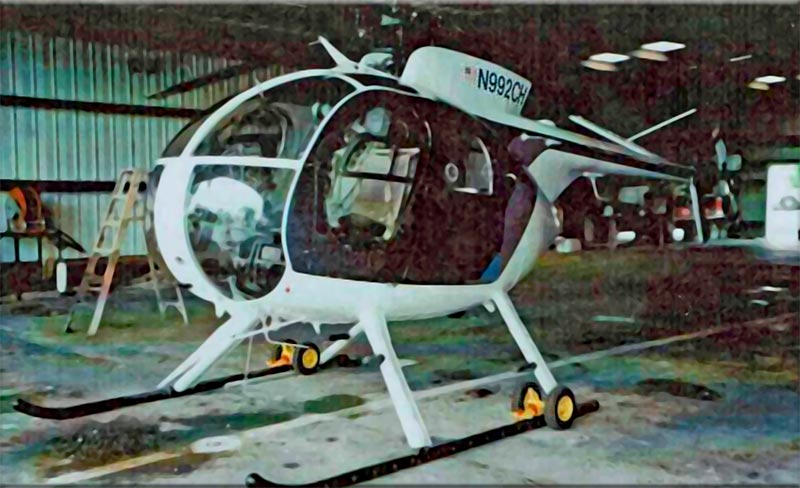 In December 1974, 795 was assigned to various Army National Guard Units in Virginia and Tennessee before ending its military service and being surplused to the Homestead, FL Police Department (Figure: 11) and given the civilian designation as N992CH in 1992.
In December 1974, 795 was assigned to various Army National Guard Units in Virginia and Tennessee before ending its military service and being surplused to the Homestead, FL Police Department (Figure: 11) and given the civilian designation as N992CH in 1992.
Figure 11: 795 as it was received from the Homestead Police Department in Oct. 1998. (Photo provided by AAHF)
In October of 1998, 795 was obtained by Michael Brady’s corporation entitled Vanderwall Aircraft Inc. out of Peachtree City, Ga. Michael was then president of Army Aviation Heritage Foundation (AAHF).
The AAHF uses restored Army aircraft in flying condition and conducts airshows around the country. Michael’s corporation restored 795 and leased it to the AAHF for use in their airshows.
 Figure 12: 795 restored to 101st colors. (Photo credit AAHF)
Figure 12: 795 restored to 101st colors. (Photo credit AAHF)
795 or Wargasm was about to be transformed into a warhorse again (Figure: 12). During the restoration, the airframe mechanics noted at least 10 bullet hole patches and thought, “if only this little bird could talk”.
It was only later that the true history of this little birds would start to unfold. But first, the restoration had to be complete. Brady decided to restore the aircraft using 101st Airborne colors. For whatever reason he used the 2/17 Cavalry Guidon, an actual unit in the 101st and in fact, Curt’s journal actually mentions flying support for the 2/17th. The result was one beautifully restored aircraft.
 Following the restoration, 795 was paired with a restored Cobra gunship and simulated pink team flying across the United States (Figure: 13). It was during these airshows that the real wartime history of 795 began to unfold.
Following the restoration, 795 was paired with a restored Cobra gunship and simulated pink team flying across the United States (Figure: 13). It was during these airshows that the real wartime history of 795 began to unfold.
Figure 13: Air Show photograph with 795 paired with a post-Vietnam modified AH-1F Cobra. (Photo credit AAHF).
During one of the first airshows a series of reunions of sorts would start that brought together Vietnam veterans that served with 795. Bill Savedge was the first that saw 795 in an air show in Fort Campbell, KY. “It was quite a shock and very emotional. Kind of like seeing a ghost”, Bill explains in an article in
Rotor & Wing.
Following Bill’s discovery, his friend and fellow pilot Curt Knapp is reunited and travels from California to Hampton, Georgia to actually fly 795 again (Figure: 14).

Figure 14: Curt Knapp flying 795, his "Favorite Helicopter” thirty plus years after Vietnam. (Photo provided by Curt Knapp)
 In 2001 Carl Betsill, exactly 29 years and 5 months after photographing 795 in Vietnam is reunited with 795 (Figure: 15).
In 2001 Carl Betsill, exactly 29 years and 5 months after photographing 795 in Vietnam is reunited with 795 (Figure: 15).
After Curt’s request for information on the Internet alerted me to the fact that Wargasm was again flying and based in Hampton, Georgia, I decided on a reunion myself.
Figure 15: Carl Betsill reunited with 795 in 2001. (Photo provided by Carl Betsill
It just so happened that I grew up in the Hampton area and had relatives still living there. On my next trip home, I made arrangements to attend a monthly meeting of the AAHF members and present them with what I knew of the history of 795 with F-Troop. Admittedly the history was slim, but at least I could describe the type of missions the aircraft was involved with. Up until that time they were only aware of the 101st history.
Being an avionics mechanic the first thing I looked for in the restoration was the avionics. Sorry to say, none of the avionics were original. Of course, it couldn’t be since this aircraft was a flying, operational aircraft. You couldn’t get it licensed with 30 year old Vietnam era avionics. I should have thought of that, but I didn’t. I jokingly suggested to Brady that he change the paint scheme to match F-Troop’s in 1972. He related that he liked to keep his airshows “family friendly”.
Airshows were not easy on 795. On April 16, 2000 she was substantially damaged by a hard landing at an Airshow in Athens, Ga. She was repaired however and continued with the shows.
Another reunion occurred at a Niagara Falls airshow in 2008. Art Cagney, crew chief in 1969 was at an airshow with his wife and grandchildren. His reunion is described in a December 1, 2008 edition of The Buffalo News. He was showing them the LOH just like the one he crewed in Vietnam. He noted that even the same three last digits in the serial number were the same, but “what were the odds of this being his aircraft?” he thought. The army had sent 800 OH-6’s to Vietnam and half of those were combat losses. This couldn’t really be his 795 could it? Well his wife Bobbie was determined to find out and contacted AAHF. It was indeed her husband’s aircraft.
Cagney and his wife travelled to Georgia at the invitation of AAHF. His first words when he saw the aircraft was “I missed you”. Cagney most likely had more combat hours with 795 than any other individual. Only a combat aviator could understand those three words spoken to a bunch of aluminum and wire.
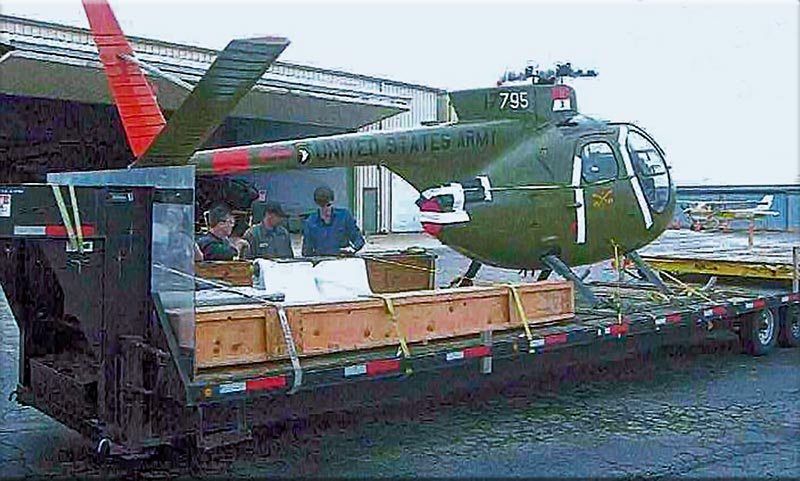 In all, five different Vietnam veterans with ties to 795 were reunited over the thirteen years she flew with the AAHF.
In all, five different Vietnam veterans with ties to 795 were reunited over the thirteen years she flew with the AAHF.
On August 15, 2012, 795’s US registration was cancelled and she was packed up and shipped to South Africa (Figure: 16). There we understand that she is still flying with a tourism business hauling passengers.
Figure 16: 795 Packed up ready for shipment to South Africa. August 2012. (Photo credit AAHF)
Dave Ripley Update 22 April 2022
My name is Dave Ripley and I encountered the Centaur website that had a written piece titled “The History of Wargasm LOH 795”.
In this piece, at Figure 9, there is a photograph of LOH 17795, Wargasm. I am the scout pilot in the photo and, somewhere in my collection of stuff, I have the original of the photo.
The photo was taken at Katum, between missions. I believe it was taken by either by my scout observers / crew chiefs, SP5 Wayne Mahana or SP4 Jessie Ayala. These two outstanding young men were always with me when we went into harm’s way and, to solve the mystery of the name, were the two responsible for the name and for painting it on the helicopter. I recall that we had a discussion of names, and one day, the helicopter was present for duty with it painted on the engine cowling. Although I thought it to be an outstanding name for the bird, I can claim no responsibility for having accomplished the task. It was Mahana and Ayala.
We were scouts in ACT 11th ACR, Phu Loi, 1971-1972, at the time. Where the ship came from and went afterwards have always been a mystery to me until now. I remember that she was incredibly powerful, extremely responsive, and healed promptly whenever small 7 mm / 51 cal holes would mysteriously appear in all parts of her skin and rotors. We never lost a cockpit window / chin bubble but we did have to replace the instrument console after an encounter up in Snoul.
795 mounted a mini-gun, which Mahana and Ayala had named the Red Mist. In the photo, you can see a small Texas flag. Above the flag, Mahana had painted:
AC 1LT Ripley
CE SP5 Mahana
Later, there was a hole, almost as if it were a period, after Mahana’s name.
Inside the engine cowling, Mahana and Ayala religiously cleaned the compartment, wiping it down and using a spoon and wet cloths to clear out any debris or foreign material. It was always spotless and the two of them maintained 795 to the highest standard, inside and out.
I vaguely recall the Kill or Be Killed slogan being painted.
We had a lot of cool names:
George of the Jungle and Widow Maker being two guns that I recall.
If you can manage to forward this to Mr Betsill, I would appreciate it. With this information, he will have a bit more of the history of 795, truly an outstanding machine and mighty warrior.
Regards’
Dave Ripley
Scout Pilot, ACT 11ACR and D Troop 229.